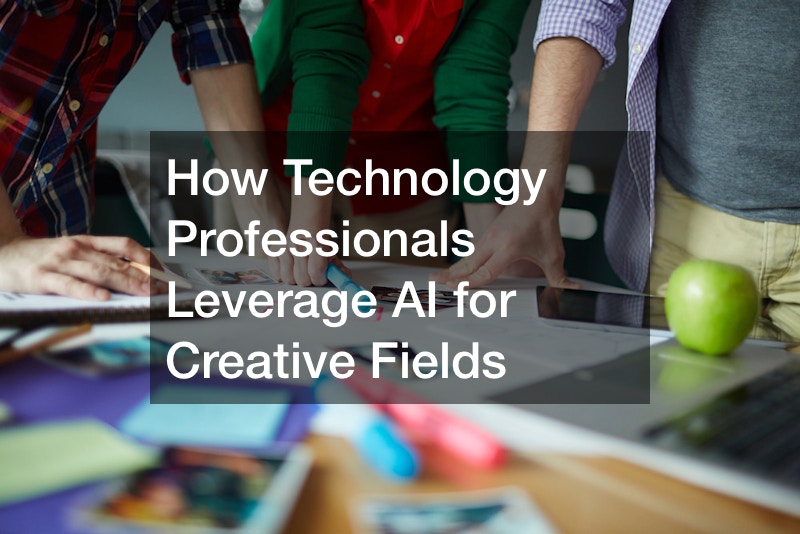Disclaimer: Computers and Technology News Digest. This site provides computers and technology content for informational purposes only.
AI has been a hot topic of discussion in recent years as technology professionals push the boundaries of what’s possible. Different industries are now adopting this technology to make their processes more efficient. Here’s how technology professionals are leveraging AI for creative fields.
1. Digital and Print Marketing

One of the applications of AI for creative fields is print and digital marketing. AI tools are drastically changing how marketers plan and execute campaigns. They help them make informed decisions that increase the effectiveness of their campaigns.
A marketer can use AI to analyze customer data such as purchase behavior and browsing history to personalize content and product recommendations. They can also employ AI for predictive analysis to identify patterns and predict customer behavior. This way, they can optimize future campaigns for better results.
Chatbots are one of the most popular developments of AI for creative fields. They help businesses improve customer service and engagement by answering customer questions and resolving their issues in real time. AI tools can also recognize images and logos, making it possible to track brand mentions and monitor the effectiveness of advertising campaigns across different media.
With inventions such as chat GPT and other AI tools, marketers also use AI to generate written and visual content, such as blog and social media posts. AI is also used in print marketing to analyze printing data and recommend the best print settings, paper type, and ink to optimize print quality. It also makes the process cost-effective.
2. Landscape Services

Landscapers are increasingly adopting AI in their operations to provide their customers with better service. They use it to automate routine tasks such as watering, fertilizing, and mowing lawns. By reducing the time and effort required to perform these tasks, they can direct their focus to other important tasks.
Smart irrigation systems are a great example of the application of AI in landscaping. These systems feature sensors that monitor weather conditions and moisture levels in the soil. They then use this data to automatically adjust the water used to irrigate plants, ensuring they receive what they need while reducing wastage.
Landscapers also use AI when designing and planning out landscapes. By employing AI-powered software to produce 3D models of a landscape design, they can test various designs and materials before beginning work on the actual project. This approach reduces the time and costs involved in the design phase of the process and gives customers a better idea of the final look of their landscape.
AI also helps with landscape maintenance. For example, automatic lawnmowers use AI to navigate lawns and cut grass to the right height. These capabilities save time and money on labor costs.
Optimizing landscaping schedules is another area where AI is useful. It slots tasks like planting, pruning, and watering for the most appropriate time of day by considering current weather conditions and growth patterns. This way, landscaping services can deliver better services to clients.
3. Kitchen Remodeling

Kitchen remodeling is another great example of the application of AI for creative fields. Navigating the kitchen remodeling process requires careful planning and execution. AI can improve the efficiency and effectiveness of this process while also ensuring the homeowner receives the best results possible.
Computer-aided design (CAD) software is a great example of the application of AI in kitchen remodeling. With this software, designers can create accurate 3D models of a kitchen. AI makes it possible to adjust these models for various parameters such as space functionality, ergonomics, and lighting, which goes a long way toward ensuring a kitchen design is both aesthetically pleasing and practical.
Machine learning algorithms, which can analyze massive volumes of data to find patterns and trends, is another application of AI in kitchen remodels. For example, it can assess data on different kitchen cabinet designs, materials, and colors. This way, designers can decide on the most appealing options for homeowners.
Kitchen remodelers can also use AI to determine how different people use their kitchens, allowing them to optimize kitchen designs to the specific needs of homeowners. For example, suppose data reveals they primarily use their kitchen for baking. In that case, AI will recommend modifications to make it more conducive to baking, such as adding extra counter space or designating a separate baking area.
AI can also be helpful in the project management aspect of kitchen remodeling. It can monitor progress, manage budgets and schedules, and even predict potential problems before they happen. In this sense, kitchen remodelers can complete projects on time and within budget.
4. Home Organization

Home organization is another great example of the application of AI for creative fields. For example, it can evaluate data about a homeowner’s possessions, such as size, how frequently you use them, and category, and offer suggestions for the optimal storage solutions for each item. AI can also offer furniture layout recommendations to maximize a home’s space.
This technology can also automate some home organization duties. These include scheduling routine cleaning tasks such as vacuuming and decluttering. AI learns a homeowner’s routines and preferences over time and automatically adjusts settings to meet their needs, allowing them to spend less time on menial tasks and more on things they love.
AI can also help with managing inventory in the home. For example, a homeowner can use it to keep track of household items such as groceries and cleaning supplies and let you know when you need to restock. It can also suggest new organizational tools and products according to their needs and preferences, making it easier to maintain an organized home.
This recent technological advancement can also analyze a homeowner’s wardrobe and storage needs by collecting data on clothing type, size, frequency of use, and the shape and dimensions of the closet. It then uses the data to recommend a custom closet design that minimizes clutter while maximizing the available storage space. The result is a functional and easy-to-organize closet.
5. Custom Jewelry
Custom jewelry design is another great application of AI for creative fields. Artificial intelligence in jewelry design has had a tremendous impact on the industry. Custom jewelry, previously the domain of master craftsmen, is now experiencing a resurgence as AI technology enables the precise and effective creation of elaborate and personalized designs.
This collaboration of technology and art is changing how we create and experience jewelry, making custom pieces more affordable and accessible. The process starts with the client’s style, preferences, and vision. AI algorithms analyze a client’s input, such as text, images, and other design inspirations, to produce original design concepts.
Through pattern recognition and deep learning, this technology can suggest ideas and combinations that a human designer may never think of, further pushing the boundaries of creativity. AI-powered software helps clients pick and choose stones and materials depending on their budget, preferences, and ethical considerations. AI can also recommend materials and gemstones based on market trends, helping customers get the best products at the best prices.
After choosing the materials and design, AI-driven software can produce intricate 3D models and lifelike renderings of the finished product. Clients can view their bespoke jewelry pieces from multiple angles and make adjustments. This way, they can ensure they align with their vision.
AI and robotics in jewelry manufacturing minimize human error and production times. The result is higher quality pieces generated at a faster rate. Computer-aided manufacturing (CAM) and Computer-aided design (CAD) technologies ensure the final product is as accurate as possible.
6. Custom Clothing
The fashion industry is also a great example of the application of AI for creative fields. Previously, custom clothing was a luxury reserved for the wealthy. However, with the recent advancements in AI, it’s becoming more accessible to the general public.
An example of this technology in this sector is virtual design assistants for custom t-shirt printing. These assistants use machine learning algorithms to generate designs based on customer preferences. Customers can input their desired fabrics, styles, and colors, and the program generates multiple designs that meet those criteria.
AI also analyzes body measurements with the help of machine learning algorithms. It uses the data to recommend patterns that fit a customer’s body type. This way, a customer doesn’t have to try out multiple sizes.
This technology is also useful in the production process. Automated machines and robots produce custom clothing pieces faster than humans. Custom clothing is now more affordable thanks to lower labor costs and faster production times.
7. Bridal Design
Custom bridal gowns are another example of the application of AI for creative fields. This technology allows designers to create dresses that are beautiful and functional. Brides can also use AI for virtual try-on experiences to preview their appearance in different gowns before settling on one.
A notable benefit of employing AI to create wedding gowns is how quickly it can develop fresh concepts. An AI system can produce hundreds or thousands of concepts in seconds, whereas a human designer would take hours or even days to complete a single design. As a result, brides seeking a one-of-a-kind dress have access to a considerably greater variety of options.
However, there’s more to AI-designed wedding gowns than just speed. They’re frequently more effective at satisfying the wants and preferences of modern brides since they use data on what’s worked in the past. For instance, AI can identify and incorporate current wedding dress design trends innovatively and freshly.
Of course, human input still plays a role in the creation of AI-designed wedding gowns. A computer program generates the original design concepts, and then human designers bring those concepts to life, ensuring the final product has great aesthetic appeal while still being functional.
8. Advertising Services
Artificial intelligence is revolutionalizing the world of advertising. While the industry has barely scratched the surface of AI’s potential, its benefits are becoming clearer. In display advertising, staying ahead and standing out from the competition is a top priority.
However, with the rapid advancements in technology, the same people advertisers want to reach are becoming part of the ‘competition.’ Consumers are now used to finding and purchasing what they want when they want, and online browsing and buying behaviors are changing faster than before. These unpredictable changes can impact a business overnight.
That’s why artificial intelligence-powered custom banner advertisements are such force multipliers for forward-thinking businesses. These technologies can analyze thousands of data points in real time, and by using their predictive powers, they can effectively use that data to create more effective ads and campaigns. Banners built with AI can deliver personalized ads based on real-time customer behavior.
9. Sign Design
Sign design is another use of AI for creative fields. A custom LED neon sign powered by AI delivers a more interactive and personalized customer experience. It can collect large amounts of data and generate insights to deliver relevant content to customers.
AI-powered digital signage also helps to increase engagement. It’s especially beneficial for businesses looking to increase dwell time or foot traffic in their office space or store. AI can also help save on costs by automating processes and reducing the need for manual labor.
10. Vehicle Wrapping
Artificial intelligence has significantly impacted the vehicle wrapping field in recent years. One of the applications of AI in this sector is the creation of 3D models. These models allow designers to visualize how a wrap will look on a specific vehicle before it’s applied.
AI algorithms can analyze the dimensions and contours of a vehicle to create an accurate 3D model, which offers a way to preview different wrap options. Truck lettering design is one aspect that greatly benefits from AI technology. It allows designers to create beautiful, eye-catching lettering that satisfies clients’ tastes.
Artificial intelligence has been a hot topic of discussion across multiple fields. It’s known for its ability to make processes more efficient. The examples mentioned in this read are just some examples of how professionals are leveraging AI for creative fields; it’s present in almost all fields in one way or another.


